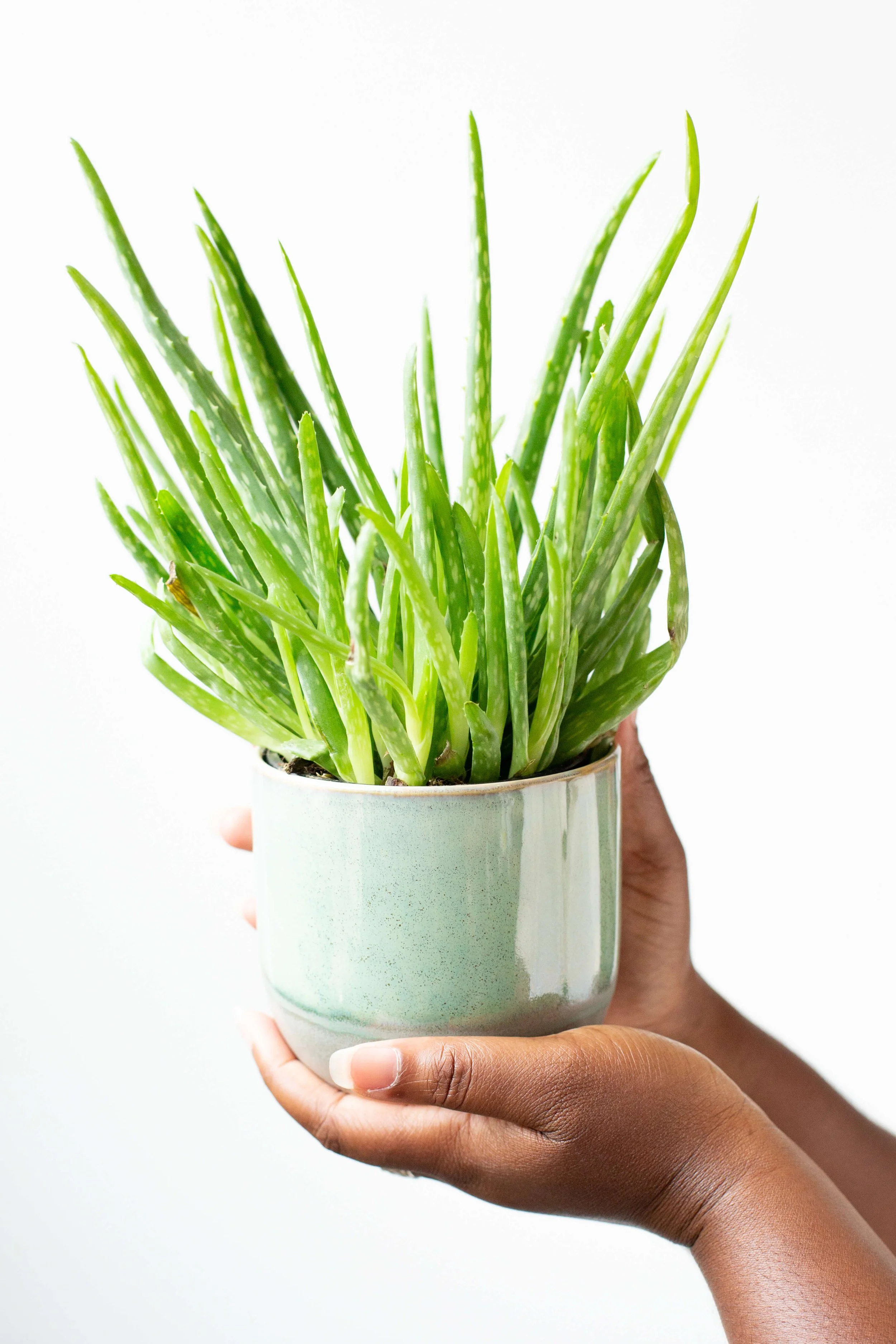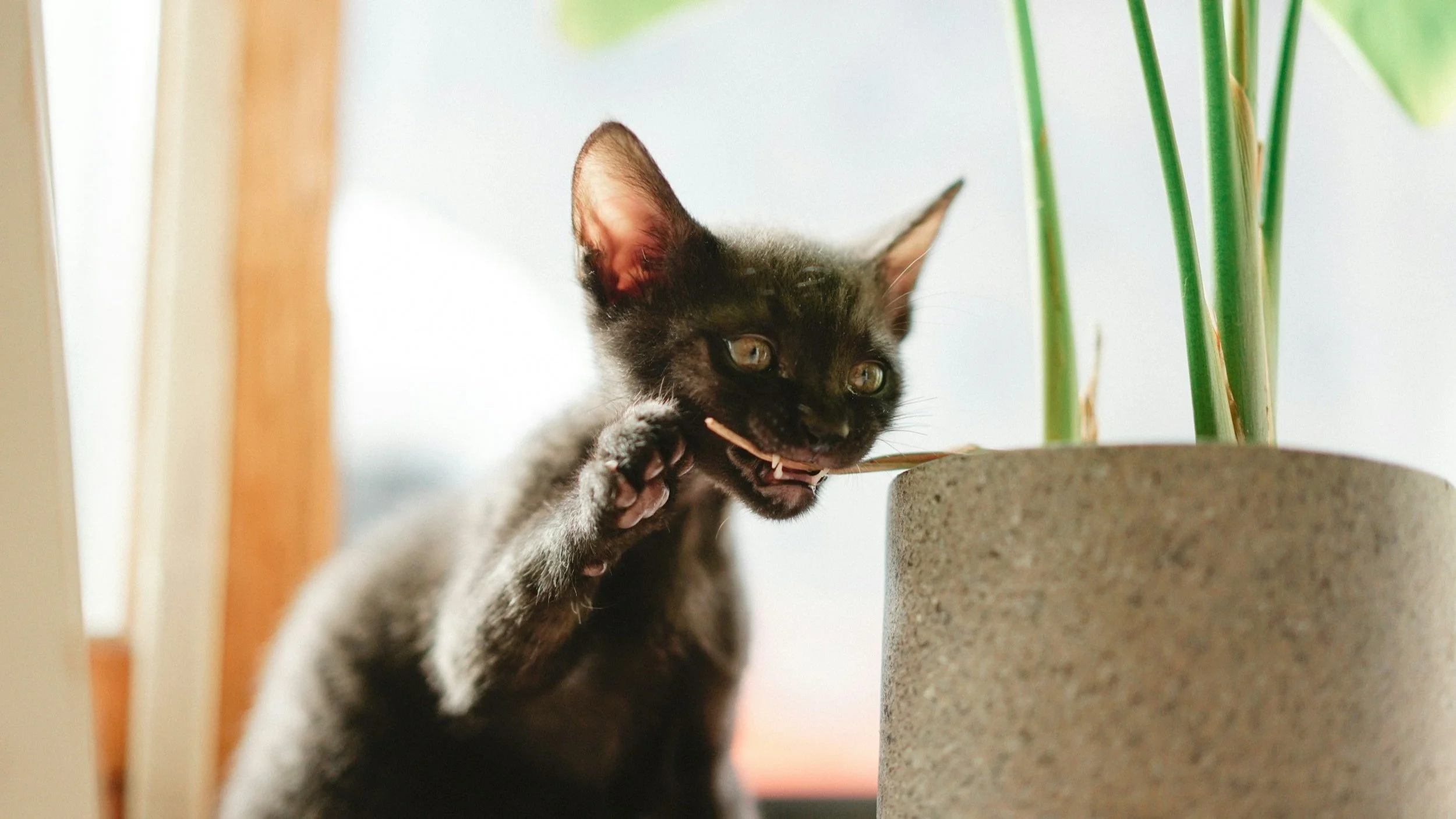Paws Off! Household Plants Harmful to Cats
A curious tabby cat reaching up to paw at a hanging spider plant in a macrame holder near a window with blue curtains.
The best of both worlds—a home full of greenery and a happy, healthy cat—is totally possible with a little education. While I don’t have cats myself, I’ve spent plenty of time with my loved ones’ cats—and let me tell you, I’ve seen the chaos firsthand. From digging up soil to nibbling on leaves to batting at plants like they’re chasing their favorite feather wand, these mischievous fur babies keep life interesting.
But here’s the thing: not all plants are safe for our curious feline friends. Based on stories I’ve heard (and a few I’ve seen up close, chaos included), I wrote this blog to help you figure out which plants to avoid for your cat’s safety—and your peace of mind. Let’s be honest though, your furry troublemakers will still disrespectfully chew, bat at, and knock over your plants. The difference? With non-toxic ones, you can at least skip the panic and just roll your eyes. So, let’s call it what it is and pick some safer “toys”—I mean, plants—for your home.
Let’s dive into what you need to know, starting with why cats can’t seem to keep their paws—or teeth—off our plants.
Why Do Cats Mess with Plants?
A playful white and tabby cat pawing at and nibbling on the leaves of a spider plant, captured from a low angle with a neutral indoor background.
Let’s face it—cats are curious creatures. They have to know what’s up in their home, and their instincts drive them to investigate everything. That means sniffing, pawing, and yes, sometimes working overtime in the bakery (kneading the soil!). Or worse, plopping themselves into your plant pots while you’re yelling, “Get away from my plant, meoww!” (Spoiler: They never listen.)
Cats love to burrow into cozy spaces like plant pots, and sometimes they can’t resist chewing on leaves to settle their stomachs. It’s instinctual—kind of like how we grab peppermint tea or ginger when our stomachs feel off.
While cats don’t know which plants are safe for them, they’re simply following their instincts—something every cat parent understands.
Understanding these behaviors helps us realize one thing: cats just can’t help themselves. So, as responsible plant and cat lovers, it’s up to us to think ahead and try our best to avoid bringing harmful plants into our homes.
Plants to Avoid
Not all plants are created equal when it comes to keeping your babies safe. Some, like lilies, can cause serious health issues—even death—while others might just lead to some mild tummy troubles. The trick is knowing which plants are a no-go so you can keep your cat out of harm’s way and still enjoy your greenery.
This isn’t a complete list of every harmful plant (there are so many out there), but it covers some of the most common ones you’ll likely come across. When in doubt, give it a quick search before adding a new plant to your collection. Your furry friend—and your peace of mind—will thank you! Let’s dive into the plants you’ll want to avoid and how they can affect your cat’s health.
Lilies
Lilies—yep, you heard that right! Not exactly a houseplant, but these bouquet favorites often end up in homes. Elegant and fragrant, but highly dangerous to the purr-son of the house.
A vibrant orange lily stem with multiple blossoms and buds displayed in a clear glass vase filled with water, set against a bright white background.
Toxin Present: Unknown compounds
Effects: Kidney failure, often fatal if untreated
Fiddle Leaf Fig
A design favorite for its large, dramatic leaves, but don’t let their trendy look fool you. These glossy leaf beauties can cause trouble for curious meowsters.
Toxins Present: Insoluble calcium oxalates
Effects: Oral irritation, drooling, vomiting, and difficulty swallowing if ingested
Pothos
Popular for its trailing vines and easy care, pothos (Devil’s Ivy) might look harmless but isn’t cat-friendly. This trailing beauty is a real troublemaker for your feline friends.
Toxins Present: Insoluble calcium oxalates
Effects: Oral irritation, drooling, vomiting, and difficulty swallowing
Snake plant
Stylish and easy to care for, the snake plant is a favorite among plant lovers—but not cats.
Toxins Present: Saponins
Effects: Nausea, vomiting, and diarrhea if ingested
Aloe Vera
Aloe is often praised for its soothing qualities, but it’s anything but soothing for your feline family member.
Toxins Present: Saponins and Anthraquinones
Effects: Vomiting, diarrhea, and lethargy
Monstera deliciosa
This trendy plant, famous for its bold, holey leaves, is a statement piece—but not a safe choice for curious nibblers.
A Monstera Deliciosa plant with large, glossy, holey green leaves in a terracotta pot, set against a clean white background.
Toxins Present: Insoluble calcium oxalates
Effects: Oral irritation, drooling, vomiting, and difficulty swallowing
Signs Your Cat May Have Nibbled a Toxic Plant:
Cats are sneaky, and sometimes you won’t catch them in the act. But if your furry troublemaker has been messing with a toxic plant, they’ll likely show some telltale signs.
A fluffy brown tabby cat lying down on a white bed, stretching one paw forward.
Here’s what to watch for if your cat decides to go full herbivore on the wrong plant:
Ongoing vomiting
Bloody or soft stool
Tremors
Difficulty swallowing
Lethargy
Hiding behavior
Drooling or excessive salivation
Labored breathing
Loss of appetite
Irregular heartbeat
Irritated skin, especially around the nose or mouth
What to Do: If you notice any of these symptoms, jot them down right away, along with the name of the plant your fur baby might have gotten into. This info is crucial for your vet to give the right care. While waiting for instructions, don’t try to make your cat vomit—it could do more harm than good. Instead, monitor them closely until you get professional guidance.
The Importance of Research
Before buying that plant—and I cannot stress this enough—research, research, research. It only takes a few minutes to double-check whether a plant is safe for your cat, and it can save you so much stress and money in the long run. I mean, would you rather spend a few minutes Googling or face a $1,000 vet bill? I think we both know the answer to that one.
The Takeaway
A playful black kitten chewing on a plant leaf in a gray planter, with soft natural light in the background.
A little education and planning go a long way. With the right research and some extra thought, you can have a home where your greenery and fur babies almost live in harmony. Let’s be real—your cats will still have at your plants, but at least you’ll have peace of mind knowing they’re safe!
Thanks for hanging out with me today! Come back next week for more plant tips to help keep your home thriving and looking great.
I’d love to hear how you’re keeping your fur babies safe while still enjoying your greenery! Share your photos or stories—whether it’s your creative plant setups or your favorite cat-safe picks. It’s always fun to see how you’re making plants and pets work together in your space!
Words By The ZEN Succulent
Inspiring everyone to embrace the world of plants, our collection features articles penned by The Sill's team of seasoned plant experts. Covering a range of plant care topics, because we truly believe Plants Bring Life, Joy and Inspirations™ .











